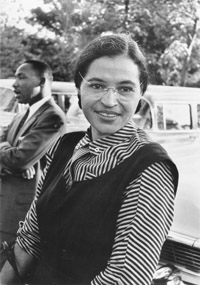ROSA PARKS AND THE MONTGOMERY BUS BOYCOTT
In Montgomery, Alabama, the law stated that the first four rows of bus seats were reserved for white people. “Colored” section was in the back of the bus but African-Americans were allowed to sit in the middle rows until the white section was full, at which point they were expected to move to the seats in the rear, stand or leave the bus if there was no room. If even one white person wanted to sit in a middle row, black people would have to move to the back, not being allowed to sit in the same row or even across the aisle from white people. Very often black people were forced to pay the bus fare to the driver but then to disembark and enter the bus through the rear door and very often the driver would close the rear door before they could get in and drive away.
One of countless African-Americans that experienced this daily was Rosa Parks.
 On Thursday, December 1, 1955 Rosa Parks boarded the Cleveland Avenue bus in downtown Montgomery. As the bus traveled along its route all of the white-only seats in the bus filled up. When the driver noticed that several white men were standing he moved the “colored” section sign behind Parks and demanded that she and three other African-Americans in her row give up their seats so that white passengers could sit. Three other people in her row complied and moved. Rosa refused. The driver then called the police and Rosa was arrested. She was bailed out of jail the very same evening by Edgar Nixon and Clifford Durr. On Thursday, December 1, 1955 Rosa Parks boarded the Cleveland Avenue bus in downtown Montgomery. As the bus traveled along its route all of the white-only seats in the bus filled up. When the driver noticed that several white men were standing he moved the “colored” section sign behind Parks and demanded that she and three other African-Americans in her row give up their seats so that white passengers could sit. Three other people in her row complied and moved. Rosa refused. The driver then called the police and Rosa was arrested. She was bailed out of jail the very same evening by Edgar Nixon and Clifford Durr.
In a trial that lasted 30 minutes, Rosa was tried on charges of disorderly conduct and violating a local ordinance. She was found guilty. After her arrest, Parks became an icon of the Civil Rights Movement.
The Montgomery Bus Boycott
On the evening of December 1, 1955 Nixon and Jo Ann Robinson, a member of Women’s Political Council made plans to organize a bus boycott. Three days later the plans were announced at black churches in the area and in The Montgomery Advertiser. It was unanimously decied that African-Americans would continue the boycott until they were treated with the level of courtesy they expected, until black drivers were hired, and until seating in the middle of the bus was handled on a first-come basis.
On Monday, December 5 at the Mt. Zion Church the Montgomery Improvement Association was formed, in order to lead the boycott effort. Its members elected a young and mostly unknown minister by the name of Martin Luther King, Jr.
Boycotters organized a system of carpools, with car owners volunteering their vehicles or themselves driving people to various destinations. Black taxi drivers charged their passengers a fare that was equal to that of the bus fare. People cycled, walked or hitchhiked to work. Some even rode mules or horse-driven buggies.
In the end the city transit system lost enough riders to be caused serious economic distress. The city then tried to force local insurance companies to stop insuring cars that were used in carpools to which the boycott leaders responded by arranging policies with Lloyd’s of London.
All this caused an outrage among white segregationists. Boycotters were attacked, beaten, fired on. Martin Luther King and E.D. Nixon’s houses were firebombed and several black churches were burned to the ground, all in an attempt to stop the boycott. The boycott lasted for 382 days and as a result the bus transit company’s finances were severely damaged.
On June 4, 1956, the federal district court ruled that Alabama’s racial segregation laws for buses were unconstitutional and on November 13, 1956 the Supreme Court upheld the ruling. This victory led to a city ordinance that allowed black bus passengers to sit anywhere they wanted and the boycott officially ended December 20, 1956.
The Montgomery bus boycott was one of the first victories of the U.S. civil rights movement. It was also one of the crucial moments of desegregation.
|

